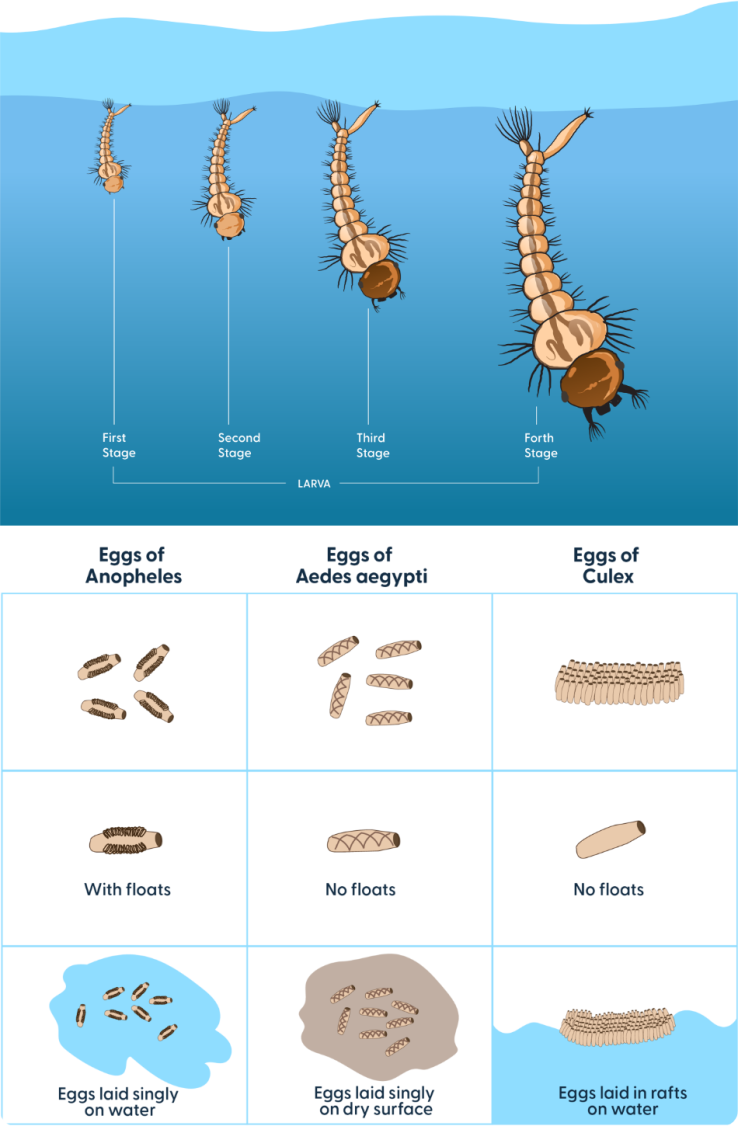Understanding Mosquitoes in Southeastern New Brunswick
What are Mosquitoes?
Mosquitoes are small flying insects found almost everywhere in the world—except Antarctica. Of the thousands of species out there, only a few bite humans—and it’s only the females who do this. They need the nutrients in blood to lay eggs, while males stick to nectar and other sugary substances.
Most of the time, mosquito bites just cause itching and swelling. But some mosquitoes can also carry serious diseases like West Nile virus, Zika virus, and Eastern Equine Encephalitis.
Life Cycle: How Mosquitoes Grow
Mosquitoes go through four life stages:
Egg – Laid on standing water or surfaces that flood and hatch when exposed to moisture. The eggs may be laid as individuals or in clusters. Depending on the species, these eggs may hatch soon after contact or once submerged from flooding and rainfall.
- Larva – often called 'wigglers' due to the way they move through the water. Mosquito larvae are aquatic and are active filter feeders, living in the water column, however they do still require surface oxygen to breathe.
Pupa – or “tumblers” due to their distinct tumbling motion, are also aquatic and remain mobile, but do not eat. Instead, they begin their transformation into adults.
Adult – Emerge from the water's surface and take flight. Both males and females will seek out plant sugars for energy. Females will also seek out blood, providing essential nutrients for egg development - helping to continue the cycle.
Depending on temperature and other environmental factors, this whole process can take anywhere from a few days to a month.

Types of Mosquitoes in Our Region
The four main types of mosquitoes you might encounter are:
Aedes:
Significant amount of diversity, with some species being more active flood/snowmelt species - emerging following rainfall and being most active at dusk and dawn - and others associated with 'container' breeding - daytime biters who breed in containers like birdbaths, flowerpots, and clogged gutters.
Anopheles:
Typically found near permanent, vegetated, water habitats in rural or semi-rural areas. Typically active after dusk and through the night. Known globally for the spread of Malaria, though Malaria is not established in Canada and cases are travel-related.
Culex (Northern House Mosquito):
Often associated with towns and cities. Typically most active at dusk and dawn, usually preferring to feed on birds, but will also bite humans. These are the primary carriers for West Nile Virus, though provincial risk is low.
Coquillettidia:
Also known as the cattail mosquito; the larvae of these mosquitoes are able to attach and use the root structures of marsh vegetation to get air, making them a particularly difficult nuisance species to treat for. These are aggressive dusk and evening biters and are a major nuisance species.

What Attracts Mosquitoes?
Mosquitoes are drawn to:
- Warmth and movement: The warmer your body, the more appealing you are.
- Breath: They can detect carbon dioxide (what we exhale) from over 30 feet away.
- Sweat and body scent: They’re attracted to compounds in sweat and some natural skin bacteria.
- Clothing: Dark or vibrantly coloured clothes make you more visible. Stick to more neutral colours to help keep mosquitos away.







